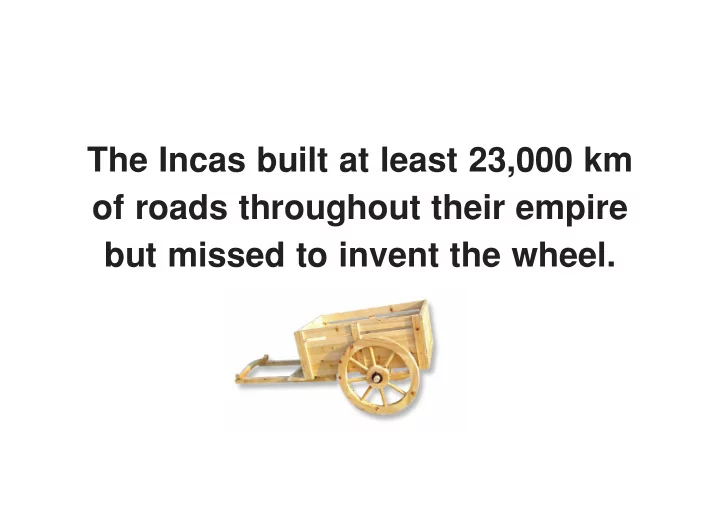

The Incas built at least 23,000 km of roads throughout their empire but missed to invent the wheel.
Let us imagine that in musical time theory we missed to discover that we can use durational ratios… q q q q q q q q 2 X e = q q ÷ 2 = e
…while still being able to notate time-discrete musical structures…
Explicit symbols for THESIS and ARSIS values � t a THESIS ARSIS
„UPBEAT“ and „AFTERBEAT“ relationships (anacrusical vs. metacrusical) at aat ta taa A B C D ata ataa aata E F G
Prerequisites for writing / reading perceptual notation: • knowing all the IOI-related perceptual thresholds • telling which IOI belongs/relates to which threshold • relational and then absolute memory for a whole range of IOI sequences • knowing how to notate different IOI sequences upon hearing them • performing and/or mentally imagining (elogizing) notated IOI sequences
A certain IOI triggers certain perceptual experiences, leading to... � ...an experimentally-defined perceptual phenomenon. � Hence, recognition of experience = recognition of IOI. � Recognition of IOI makes possible its graphical notation. � Graphical notation makes possible first-sight production. � And: apperception / educated perception for the recognition/production of a wide range of IOIs needed.
Perceptually-defined isochronal tempi – I IOI ≈ 100ms (MM ≈ 600) 100 aaaaaaaaaaaaa Related perceptual phenomena: • the beginning of the IOI range for the „central tendency for habitually perceived durations“ (Fraisse, 1964) • the beginning of the „macro-temporal region that allows for the recognition of temporal features“ (Roederer, 1975) • the threshold of subjective rhythmization (Bolton, 1894) • the fastest compound tempo (i.e. when grouped in three) (London, 2004)
Perceptually-defined isochronal tempi – II IOI ≈ 200ms (MM ≈ 300) 200 aaaaaaaaaaaaa Related perceptual phenomena: • the minimum duration of a „present moment“ (Clynes, 1989) • the minimum acton (Clynes, 1989) • the minimum duration of the perceptual present (Pöppel, 1988) • the minimum interval between two stimuli for subjects to have enough time to transfer their attention from one stimulus to the other (Feilgenhauer, 1912) • threshold of (note-to-note) synchronization (Fraisse, 1982)
Perceptually-defined isochronal tempi – III IOI ≈ 250ms (MM ≈ 240) 250 aaaaaaaaaaaaa Related perceptual phenomenon: • the threshold between the holistic vs. analytical processing of durations (Michon, 1964)
Perceptually-defined isochronal tempi – IV IOI ≈ 420ms (MM ≈ 143) 420 aaaaaaaaaaaaa Related perceptual phenomenon: • sustainable rate of (continuous) attention shift (Fraisse, 1964; Feilgenhauer, 1912)
Perceptually-defined isochronal tempi – V IOI ≈ 500, 550, 600ms (MM ≈ 120, 109, 100) 500 550 600 ååååååååååååå Related perceptual phenomenon: • (central nervous system) resonance-specific IOIs (van Noorden & Moelants, 1999) • IOI 600ms – optimal rate of attention shift (Mager, 1925)
Perceptually-defined isochronal tempi – VI IOI ≈ 700ms (MM ≈ 86) 700 ååååååååååååå Related perceptual phenomenon: • the last non-gap defined IOI (ideal unit of perceptual present) (Fraisse, 1964) • the optimum interval for immediate succession (Oléron, 1952)
Perceptually-defined isochronal tempi – VII IOI ≈ 800ms (MM ≈ 75) 800 ååååååååååååå Related perceptual phenomenon: • the first gap defined IOI (cf. Fraisse, 1964)
As the temporal gap becomes the dominant feature for IOIs above 1000ms (Fraisse, 1964), all isotempi with IOIs between 800 and 1500ms will be related to their divisional value (i.e. 1÷2) 1400 ååååååååååååå 700 + 700 ååååååååååååå
Other types of pulsatory structures – I œœœœ t Crushing notes: „Dotted“ structures: 400 400 etc. ta ta at at etc.
Other types of pulsatory structures – II Sudden shifts of temporal windows Û Û tatatatq tata
Possibility for a wholly (a)perceptual approach: a non-metrical, non duration-relational representation of musical time 2 x =3 x 3 x =1 e . 3 e . = 2 e q =1400ms
Implications: Do you speak „Time-ish“? • the promise of a perception-based musico-temporal language with a corresponding notational system • creative exploration of our overall discrete-temporal competence • less feet-tapping and duration-relating, • more cognition, • more educated temporal perception.
Final statement The perceptual notation is open-source. Feel free to use, modify and enhance it. e-mail for help at pogo@mailbox.ro 2 more detailed papers on this topic downloadable at: www.zeuxilogy.home.ro
Recommend
More recommend